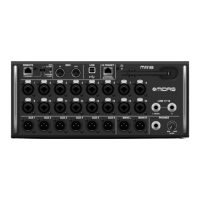14 M AIR User Manual
5. M AIR for iPad
The M AIR applications for iOS, Android and Mac/Win/Linux allow all of the
physical controls and features normally found on analog mixers to be adjusted
digitally, and also allow eects and routing to be fully adjusted, all from a remote
location away from the input box. This results in a very compact, yet full-featured
mixing solution that can be operated while moving about the venue or studio.
This chapter will discuss the software's functionality on an iPad.
5.1 Main Screen
The main screen provides access to all 16 channel faders, Aux in, and FX send
levels, as well as navigation to preamp controls, meters, FX slots and more.
Thechannel strips can be swiped side to side to reveal all 21 faders, and the
selected bus fader is always visible.
1. The Channel Strip control section gives a quick reference to the status of
phantom power, aux send levels, pan, etc., but no adjustments are made
directly on this screen. Touch anywhere inside a channel’s top strip section to
edit parameters.
2. Touch a channel’s Solo button to send the channel to the solo bus.
Thebutton will light yellow to indicate that a channel has been soloed.
3. Each channel has a dedicated meter to monitor the input level. If the meter
reaches the red clip lights, lower the gain control on the Input screen (5.2).
4. The Channel Fader adjusts a channel’s level, or adjusts the aux/FX send level,
depending on which layer is selected on the right-hand side (see callout 11).
5. Touch a channel’s Mute button to mute the channel. The button will light red
when muted.
6. The Meters, Shows, Snapshots, Eects, Routing and Setup buttons allow
direct access to these menus.
7. Engage the auto mix groups with these buttons. See section 5.9 for details.
8. Engage one of the 4 Mute Groups with these buttons. Assignments can be
made by navigating to a channel’s Output tab.
9. The Layers menu lets you select which channels/buses are visible on the
main screen. Custom layers can also be created and edited, for example,
to access only the drum channels.
10. The Solo Clear button releases all soloed channels.
11. The Fader Bank buttons alter the function of the channel faders. Whenset
to Main, the faders adjust the channel volume levels sent to the main
bus, andthe overall main output. When one of the Aux or Eect buttons
are selected, the faders adjust each channel’s send level to that bus for
monitoring or eects routing. The level for the Aux or Eect bus that is
currently selected can be adjusted where the main fader normally appears.
5.2 Input
The Input section allows adjustment of the most common preamp parameters
such as gain and phantom power. This is accessed by pressing the top of the
Channel Strip of the channel you wish to modify. If another menu such as Sends
or Gate come up instead, the menus can be swiped side-to-side without
returning to the Main Screen.
1. The Link button allows adjacent channels to be linked as a stereo pair.
Moving one of the linked channels‘ fader will also adjust the other channel.
2. The Phase button inverts the phase.
3. Use the Mic/USB switch to determine whether the channel is fed by
the microphone input or by a signal from a DAW via the multi-channel
USBconnection.
4. The Mic Gain knob adjusts the input gain for the currently selected channel’s
mic preamp.
5. The USB Trim knob adjusts the digital trim for the signal coming from the
connected computer. The Mic/USB switch must be set to USB.
6. The HPF Freq knob adjusts the frequency of the lter, allowing unwanted
low frequencies to be removed.
7. Engage the HPF (high-pass lter) with this switch.
8. Press this button to engage the phantom power. It is best practice to engage
phantom power before running audio in a channel, allowing all voltages to
stabilize and prevent any noise during the performance.
5.3 Sends
The Sends tab allows the currently selected channel’s signal to be routed to the
6 Aux outputs and to the 4 Eects processors. Aux and Eects routing can also
adjusted using the fader banks on the right-hand side of the screen.
5.4 Gate
The Gate tab allows a noise gate to be engaged and adjusted to remove
unwanted noise. To accommodate various levels of mixing expertise, a standard
or advanced screen can be selected. The standard view oers 4 presets and a
threshold adjustment, while the advanced view allows ne adjustment of the
gate parameters.
(7)
(8)
(9)
(10)
(11)
(1)
(2)
(3)
(4)
(5)
(6)
(1)
(2)
(6)
(3)
(8) (7)

